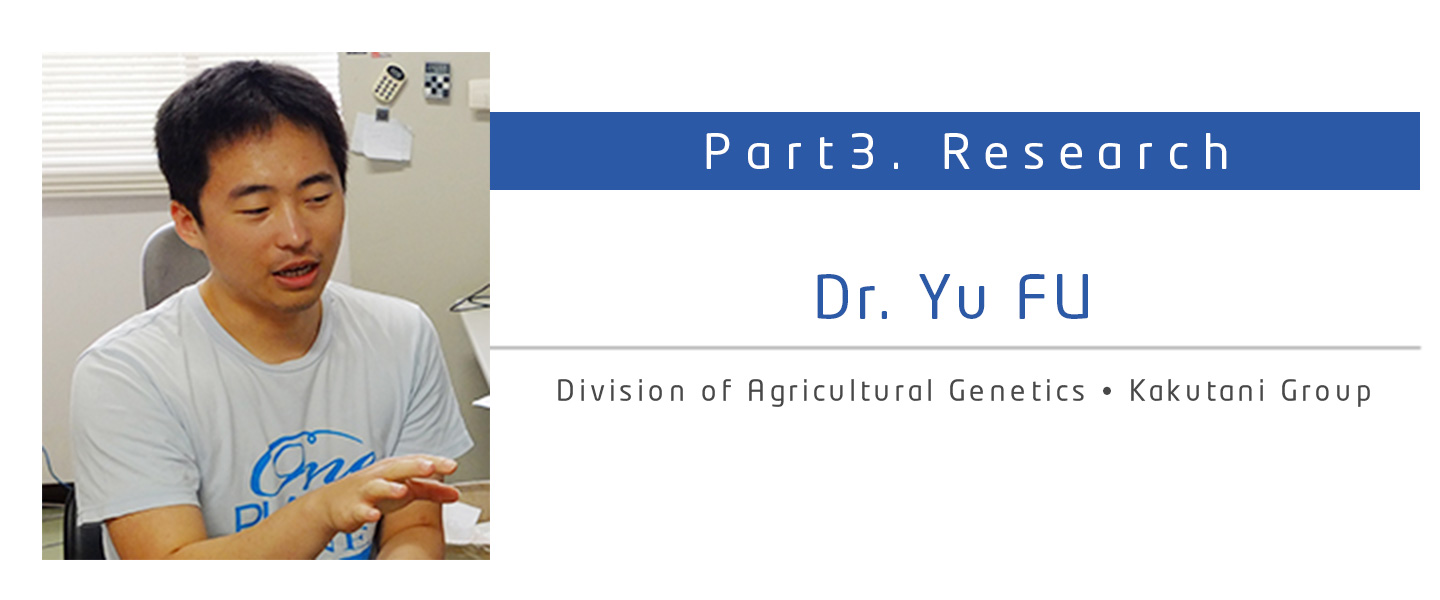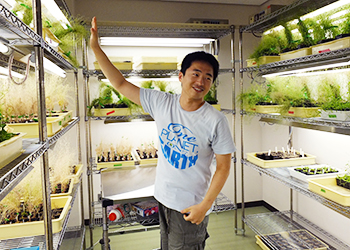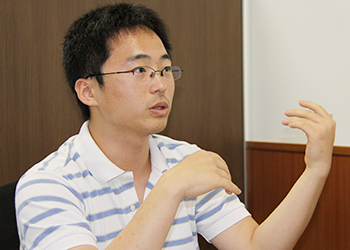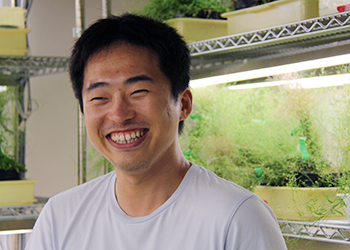Dr. Yu FU

Question 1 Would you mind to explain us your research aim?
I research activity of Transposable elements (TEs) to counter-act DNA methylation and silencing by the host in Arabidopsis thaliana at Kakutani Laboratory.
TEs have a major impact on genome evolution, but they are potentially deleterious, and most of them are silenced by epigenetic mechanisms, such as DNA methylation. VANDAL21 is a group of DNA TEs found in the genome of Arabidopsis thaliana. By structural similarity of encoded genes, VANDAL21 has been classified as a member of Mutator-like elements (MULEs). Our lab already found that some of VANDAL21 copies transpose in the background of reduced genomic DNA methylation in A. thaliana mutant ddm1 (decrease in DNA methylation).
Using genomic DNA of the self-pollinated ddm1 mutants, I identified a mobile copy of VANDAL21 family by PCR-based methods and whole-genome re-sequencing and called it “Hiun (Hi; Japanese for “flying cloud”)”. It was named after “Hiunkaku” which is one of Kyoto’s three great pavilions” in the grounds of West-Hongan-ji Temple. Hi and “Hiunkaku” are both asymmetric and Hi reminds us of “flying cloud” from its transposable feature.
Unlike most of other mobile MULEs, the mobile copy does not have terminal inverted repeat (TIR). This is unusual because TIR has generally been thought to be the substrate for transposase. Despite the unorthodox structure, Hi excised and transposed as other typical MULEs with TIR. Hi is silent in wild-type plants, but it transposes when DNA methylation is abolished.
Hi has three open reading flames (ORFs), which I named vanA, vanB and vanC. In order to know role of each ORF in the trans-acting effects of Hi transgene, I generated three types of transgenes with deletions for each of the three ORFs. The DNA de-methylation effect was abolished in transgene with deletion of vanC (△vanC), suggesting that vanC is essential for the de-methylation. On the other hand, △vanB (transgene with deletion of vanB) had the de-methylation activity indistinguishable from full length Hi transgene. △vanA (transgene with deletion of vanA) had de-methylation activity for one of the two terminals of endogenous Hi, which is upstream of vanC, but de-methylation activity was much reduced in the terminal region upstream of vanA.

I also examined effect of △vanA for the mobilization of endogenous Hi. In most of the transgenic lines, I could detect excision of endogenous Hi. The results were surprising, because vanA encodes a putative transposase, which presumably catalyzes the transposition. However, subsequent analyses revealed that vanA transcript accumulates in △vanA lines, suggesting that endogenous vanA was de-repressed in the presence of △vanA transgene. △vanA transgene contains two ORFs, vanB and vanC. In order to test if vanC is sufficient for the transcriptional re-repression of endogenous vanA, I introduced a transgene with deletion of both vanA and vanB (△vanA;B). △vanA;B induced transcription of endogenous vanA and vanB. △vanA;B also induced excision of endogenous Hi, and DNA de-methylation of one terminal of endogenous Hi. These trans-acting effects are indistinguishable from those by △vanA, suggesting that vanC, rather than vanB, is responsible for these trans-acting effects of the Hi transgene.
At the moment VANC doesn’t directly contribute to human well-being as it is only found in A. thaliana and related species. However, we can find transposons in various creatures. I hope I can show something useful and revolutionary through my future research.
Question 2 How did you know NIG?

I was an undergraduate student in Tsukuba University. When I was wondering if I should take a postgraduate course in Tsukuba or somewhere else, an ex-NIG member came to our university and gave us a seminar. That’s how I knew about NIG. After the seminar, by chance I met Professor Kakutani at the graduate school I was then interested in. I liked him – not only his research but also his atmosphere – typical scientist-like!
Then I joined a SOKENDAI bus tour “Graduate Students’ Recruitment Session” organised by NIG and visited the Kakutani Lab. The tour allowed me only a half day visit, so I asked Professor Kakutani to host me for five days at his lab. During this stay, I tried an experiment and talked with students, then decided to take an entrance exam for the Department of Genetics, SOKENDAI. (Note: NIG functions as the Department of Genetics, SOKENDAI and offers PhD programmes in Genetics)
Question 3 What is a merit of working/studying at NIG?
The research environment at NIG is good. It is fully equipped and each lab carries out interesting research. There is no big hierarchy between faculty and staff or students so that I could ask their opinions when my experiments seem to be going nowhere. Communication across different labs is also attractive. I met people through journal club co-hosted by the Kakutani Lab and others. I have visited them taking my Nintendo DS. Sadly that lab moved away to the Kyushu area, but in this New Year, several labs including them lodged together in Saga Prefecture. Each participant made a 15 minutes presentation – we just kept on and on during the daytimes. It was a kind of hard work, but we spent enjoyable evenings.
Question 4 What’s your impression of Mishima city?
My father is also a researcher. I was 13 years old when we came to Tsukuba for his work from Shengyan, China. The population of Shengyan is around 7,000,000, I guess. Although Sapporo is a sister city as both cities locate at the same latitude, Shengyan is colder because it is inland.
As I’m a very indoor person, I’m not fussy about where I live. My first impression of Mishima was that it is more rural than I imagined. I found it difficult to cycle around here as the roads are so narrow just because Mishima is an old town. These days I walk to NIG. And I noticed electric cables all spread over our heads and not many trees lining the streets. I miss Tsukuba – a well-organised college town, there are plenty of space like three lanes on each side of road and lots of green on the streets.
Question 5 How do you spend your day off/ holiday?
Although I’m a well-known indoor person, I sometimes do sports – indoor sports, of course! I once was the head of the NIG badminton club until I graduated from SOKENDAI. I’m not head of the club anymore but still playing twice a month or so. We have 12-13 members on a good day.
I always listen to music – a wide range of genres from classical music to Hip Hop. There are not many concerts going on in Mishima, so I go to Tokyo or Yokohama for cultural stimulation. Travel expense sometimes costs me more than a live ticket though…
Question 6 What would you like to achieve in the future?

Research could be fun when you get a good result, you know. My experiments often go wrong, but I am really thrilled when I manage to achieve a key result. On the other hand, no matter how great my private life goes, I feel down if my experiments keep failing.
Basically I shouldn’t stay at one place for a long time. I’ve lived in Japan many years. So I should move on.
It is hard to guess how I will be in 20 years a time. But I would like to be still involved in research – in such a thrilling world!
transcription & translation : Chikako Miura (General Affairs/Education Team) Part1. Research
Back














